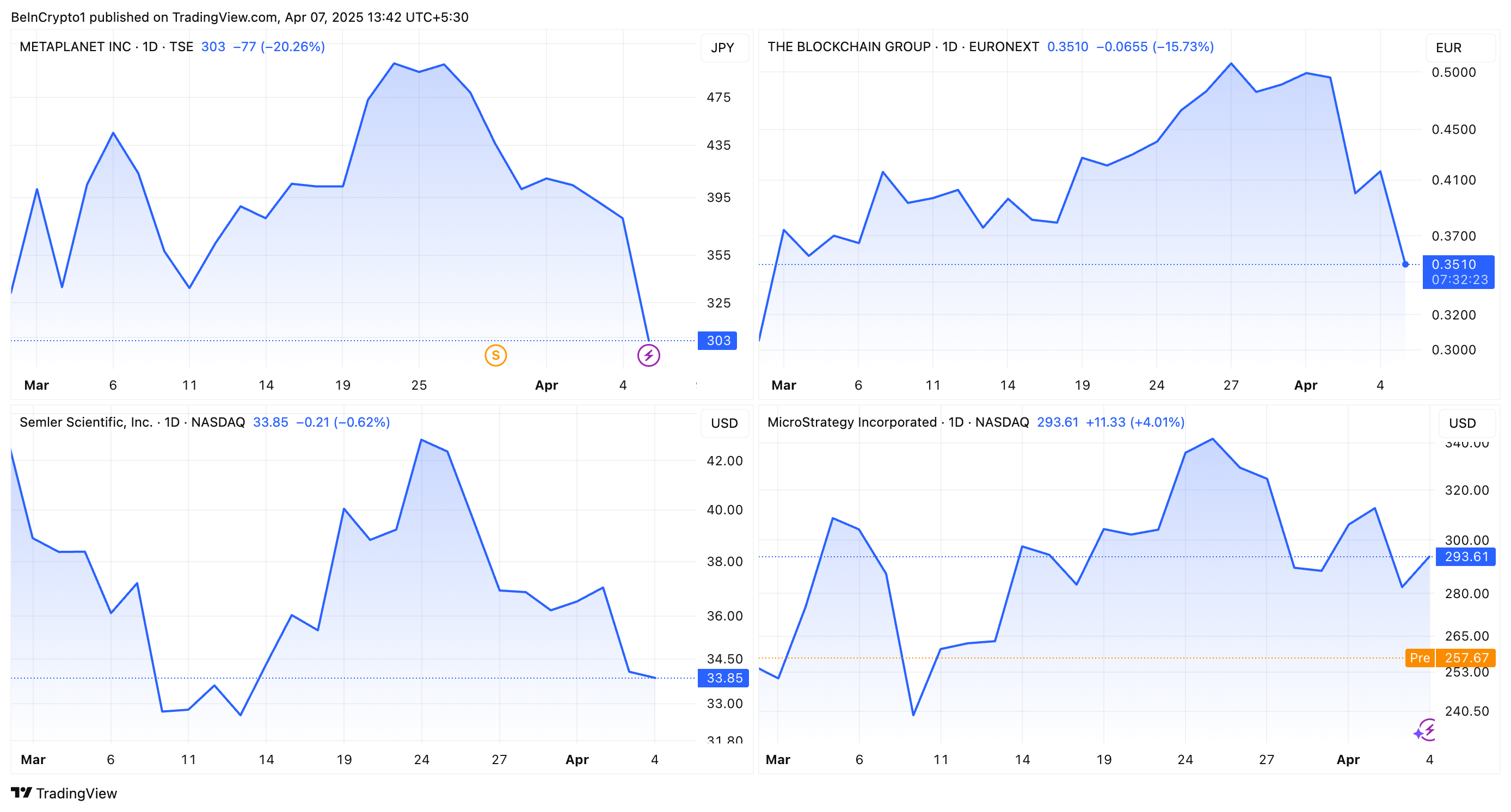Bitcoin
Bitcoin Drop Hits Companies Holding Digital Assets Hard

Public companies are grappling with mounting losses from their Bitcoin (BTC) reserve strategies as the cryptocurrency’s value plunges.
This comes as BTC dropped below $80,000, sparking renewed debate over the risks of corporate investments in digital currencies.
Are Bitcoin Reserve Strategies Backfiring for Companies?
The week opened on a grim note for the cryptocurrency market, with many referring to it as a “Black Monday.” According to BeInCrypto data, Bitcoin saw a sharp decline of 9.6% in the past 24 hours, falling to $75,089 at the time of writing.

The liquidation figures have been equally staggering. According to Coinglass, Bitcoin experienced the highest liquidations in the same timeframe, totaling $474 million. Of that, $405.7 million came from long liquidations, while $68.2 million was from short liquidations.
Importantly, companies holding Bitcoin reserves have not been spared from the recent market bloodbath. Many now face significant unrealized losses amid Bitcoin’s sharp downturn.
According to data from Bitcoin Treasuries, the NGU ratio, which measures the difference between the current Bitcoin value and the cost basis of a company’s holdings, has turned red for many firms.
This indicated that the current market price of Bitcoin is now below the acquisition cost for many institutional investors. For example, Metaplanet (3350.T) is experiencing a 12.4% unrealized loss on its Bitcoin holdings. The company currently holds 4,206 Bitcoins, valued at approximately $314.7 million, with an average cost per Bitcoin of $85,483.
Similarly, The Blockchain Group’s (ALTBG.PA) portfolio is down 14.4%. Holding 620 Bitcoins valued at $46.39 million, the company’s average cost per Bitcoin is $87,424.
Semler Scientific (SMLR) has also felt the impact, with a 14.7% loss on its portfolio. The company holds 3,192 Bitcoins valued at $238.9 million, with an average cost of $87,850 per Bitcoin.
Even Strategy (MSTR), an early player in corporate Bitcoin adoption, is facing challenges. Since beginning its Bitcoin acquisition in August 2020, the company has accumulated 528,185 Bitcoins, valued at $39.5 billion, with an average cost of $67,485 per Bitcoin, resulting in an overall profit of 10.9%.
However, data from SaylorTracker reveals that all Bitcoin purchased by the firm since November 2024 is currently at a loss. These acquisitions were made at prices ranging from $83,000 to as high as $106,000 per Bitcoin.
Meanwhile, the decline in Bitcoin’s value has had a significant ripple effect on the firms’ stocks. 3350.T saw a sharp 20.2% drop in its stock price, while ALTBG.PA experienced a 15.8% decline.

SMLR experienced a smaller 0.6% dip but still reflected the broader market trend. Lastly, MSTR dropped 11.2% in pre-market trading despite some initial resilience.
Amid this market crash, Peter Schiff, economist and long-time Bitcoin skeptic, took aim at Strategy.
“Attention Saylor, now that Bitcoin is below $80,000, if you want to prevent it from crashing below your average cost of $68,000, you had better back up the truck with borrowed money today and go all in,” he posted on X.
The economist further predicted that the company’s Bitcoin strategy could lead to its downfall.
“It will end with the bankruptcy of MSTR,” Schiff stated.
He also questioned Bitcoin’s value as a safe haven asset. Schiff stressed that the coin’s substantial decline compared to other assets makes it an unreliable store of value, especially during market selloffs.
Disclaimer
In adherence to the Trust Project guidelines, BeInCrypto is committed to unbiased, transparent reporting. This news article aims to provide accurate, timely information. However, readers are advised to verify facts independently and consult with a professional before making any decisions based on this content. Please note that our Terms and Conditions, Privacy Policy, and Disclaimers have been updated.
Bitcoin
Bitcoin Holders are More Profitable Than Ethereum Since 2023

New data from Glassnode suggests that Bitcoin’s MVRV (Market Value to Realized Value) has been higher than Ethereum’s for 812 consecutive days. This means that the average BTC investor has accumulated much larger profits than their ETH counterpart since 2023.
Due to recent losses, Ethereum’s MVRV actually fell below 1.0, suggesting that the average investor has lost money. It may be undervalued and well-posed for a resurgence, but this will take time.
Bitcoin vs Ethereum: Which is More Profitable?
Despite a few recent market turmoils, the price of Bitcoin is doing reasonably well right now. Although much of its gains since Trump’s election have been wiped out, its pre-election value spent most of 2024 at a shelf near its previous all-time high.
According to new data from Glassnode, Bitcoin’s investor profitability is far above Ethereum’s.
“Since November 2022 (FTX collapse), Bitcoin’s realized cap has grown by $468 billion (+117%), while Ethereum’s increased by just $61 billion (+32%). Bitcoin investors have held consistently larger unrealized profits than #Ethereum holders since January 2023. BTC investor profitability has exceeded ETH for 812 consecutive days – an all-time record,” Glassnode said.
Glassnode came to these conclusions by analyzing both tokens’ MVRV and their ratio of market value to realized value. This metric compares the listed price of Bitcoin and Ethereum to the actual price at which these tokens were most recently traded.
Despite maintaining similar MVRVs for a prolonged period, Bitcoin is plowing well ahead today:

While Bitcoin has been more volatile than Ethereum, the altcoin has seen a much smaller uptick during bullish cycles. For instance, in the latest bull run between October and December 2024, Bitcoin surged by nearly 70%.
In the same period, Ethereum’s price increase was less than 50%. Yet, if we look at the drop during the current market downturn, BTC lost 3% in the first week of April, while ETH lost over 15%.
Meanwhile, the altcoin’s investor sentiment is also dropping. Major whales who HODL’ed the token for many years are now selling their ETH holdings.
Also, the average Bitcoin holder enjoys an MVRV of around 2.0, meaning that they have huge unrealized gains. Most of their counterparts have an MVRV below 1.0, signifying that they have lost money. These data points are concerning, especially for the median ETH holder.
However, there’s a silver lining. Ethereum recently fell to a yearly low, but there’s also a strong uptick of new investors. New developments, like the SEC approving ETH ETF options trading, could spur a recovery.
In other words, Ethereum may be highly undervalued and, therefore, an attractive investment.
Still, for the time being, Bitcoin holders are in a much better position than ETH holders. Ethereum is still the second-largest cryptoasset by market cap, and it can always make a comeback. This will almost certainly pose a significant challenge.
Disclaimer
In adherence to the Trust Project guidelines, BeInCrypto is committed to unbiased, transparent reporting. This news article aims to provide accurate, timely information. However, readers are advised to verify facts independently and consult with a professional before making any decisions based on this content. Please note that our Terms and Conditions, Privacy Policy, and Disclaimers have been updated.
Bitcoin
This is Why Hoskinson Thinks Bitcoin Will Hit $250,000 in 2025


Cardano founder Charles Hoskinson believes that Bitcoin can reach $250,000 by the end of the year. He thinks that tariffs are already priced in and future annoucements will be a ‘dud’ for the crypto market.
In the short term, he claimed that crypto markets will stall for three to five months as TradFi finds a new normal. Afterward, Bitcoin’s ability to transcend borders will give it a leg up over trade organizations and legacy banks.
Why Is Hoskinson Betting on Bitcoin?
The threat of Trump’s tariffs has caused a lot of turmoil in the crypto markets lately. The crypto market was always volatile, but the on-and-off tariffs introduced a new level of chaotic volatility for digital assets.
However, Cardano founder Charles Hoskinson is staking out a bold claim, stating that Bitcoin could rise to $250,000:
“Crypto benefits in the long term. Your only option for globalization is crypto. If you want to business with countries the US, Russia, [or] China doesn’t like… you can no longer do that through trade organizations or legacy banks. You can only do that through crypto. I think Bitcoin will be over $250,000 by the end of this year or next year,” Hoskinson predicted.
Essentially, Hoskinson’s bullish case for Bitcoin’s price gains is tied to the industry’s roots, which are decentralization and anonymity. Bitcoin was created in the aftermath of the 2008 crash, and it was intended to circumvent the often unfair overreach of traditional financial institutions.
If Trump’s tariffs lead to a breakdown in the global system of trade, Bitcoin could fill that void.
Naturally, Bitcoin already has a major use case in helping countries avoid US sanctions, but that doesn’t represent the entirety of Hoskinson’s argument. Ironically, in the short term, he believes that the tariffs will be a “dud.”
The Cardano founder thinks that markets will adjust to the new state of affairs, pouring cheap money into crypto. US stablecoin regulation will also help this process.
However, these short-term gains are just one piece of the puzzle. Hoskinson believes that tariffs, the Russo-Ukraine War, and other factors are all major contributors to this global breakdown that will help Bitcoin.
Crypto is currently more well-integrated into TradFi than ever, making it vulnerable to a wide array of macroeconomic concerns.
The industry is also gaining users quickly, with the total number of holders increasing 13% year over year. Bitcoin’s user base can take advantage of what Hoskinson calls “a huge wave of speculative interest” towards the end of the year.
The asset’s international positioning will keep it from being too reliant on this speculation forever.
Disclaimer
In adherence to the Trust Project guidelines, BeInCrypto is committed to unbiased, transparent reporting. This news article aims to provide accurate, timely information. However, readers are advised to verify facts independently and consult with a professional before making any decisions based on this content. Please note that our Terms and Conditions, Privacy Policy, and Disclaimers have been updated.
Bitcoin
Florida Bitcoin Reserve Bill Passes House With Zero Votes Against

Florida’s Insurance and Banking Subcommittee unanimously passed a bill supporting a state-level Bitcoin Reserve. It will now head to the legislature. This is the first state Bitcoin reserve bill to pass the House committee with zero votes against it.
Although most of the initial comments were highly skeptical due to recent market chaos and fiscal conservatism, state sponsor Webster Barnaby and other supporters won them over.
Florida Advances in the State Race for a Bitcoin Reserve
Over the last few months, a spate of Bitcoin Reserve bills has swept through US state legislatures. Although these initiatives have seen setbacks due to funding concerns, they have also had noteworthy successes.
Today, the US crypto industry can count on another win, as Florida’s Insurance and Banking Subcommittee unanimously voted to approve a Bitcoin Reserve:
“Bitcoin Strategic Bill Passes House Committee unanimously. Today’s remarks was a historical moment, and I am proud to have been a part of it with Samuel Armes and Florida. Bitcoin is the PEOPLES currency,” claimed Joshua Jake, who spoke in favor of the initiative.
Florida’s Bitcoin Reserve bill also marks a new milestone, even if it’s only a Subcommittee vote. This bill passed with complete bipartisan support, without a single Democrat siding against the bill.
One of the Representatives either abstained or was absent, but everyone present was swayed by the argument.
The bill proposes that the Flordia state government invest $1.5 billion in public funds to build a strategic BTC reserve.
Although the Subcommittee hearing was initially skeptical, partially due to recent tariff-imposed chaos, sponsor Webster Barnaby maintained an impassioned defense.
By the end, he and the Bitcoin Reserve bill’s other supporters had wholly won over this Florida Subcommittee. From here, it will head to the legislature.
Over 30 states have proposed reserve bills so far. Arizona is currently leading the race, with both of its Bitcoin bills reaching the final stage and waiting for a decision from the Senate.

Meanwhile, similar bills have already failed in five states, including Montana and Wyoming. The fact that Florida’s House Committee showed unanimous support could provide the state with an edge in this race.
Disclaimer
In adherence to the Trust Project guidelines, BeInCrypto is committed to unbiased, transparent reporting. This news article aims to provide accurate, timely information. However, readers are advised to verify facts independently and consult with a professional before making any decisions based on this content. Please note that our Terms and Conditions, Privacy Policy, and Disclaimers have been updated.
-

 Market23 hours ago
Market23 hours agoExperts Reveal What Could Drive Ethereum’s Price Recovery
-

 Market21 hours ago
Market21 hours agoIs Trump’s Tariff Delay Masking a Crypto Dead Cat Bounce?
-

 Altcoin18 hours ago
Altcoin18 hours agoAnalyst Reveals How XRP Price Can Hit $22 If BTC Rallies To This Level
-

 Altcoin19 hours ago
Altcoin19 hours agoWill Q2 2025 Mark the Return of Altcoin Season?
-

 Bitcoin17 hours ago
Bitcoin17 hours agoBullish Signal for Bitcoin in 2025?
-

 Market17 hours ago
Market17 hours agoSolana (SOL) Jumps But Smacks Into $120 Resistance Wall—Can It Break Through?
-

 Blockchain22 hours ago
Blockchain22 hours agoBlockchain in the Ballot Box? NY Assembly Considers Tech to Fight Election Fraud
-

 Market18 hours ago
Market18 hours agoMeme Coin FARTCOIN Hits Two-Month High, Could It Reach $1?






















